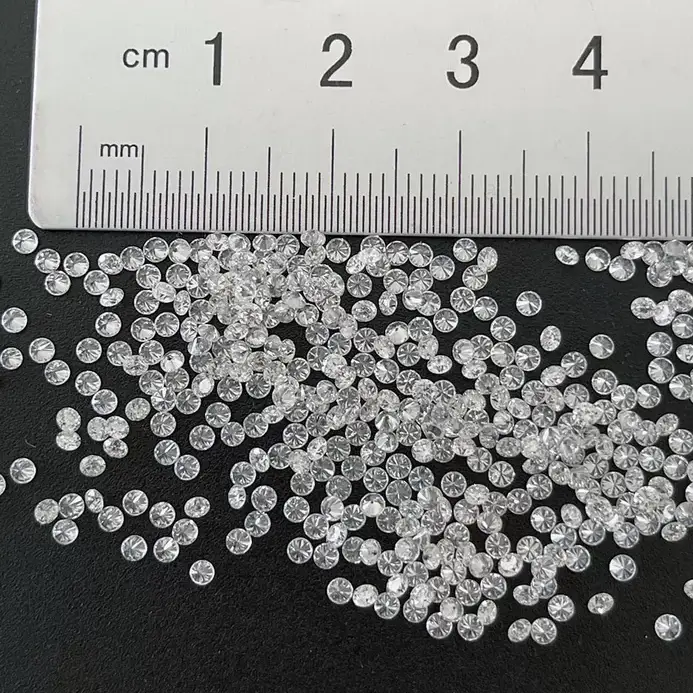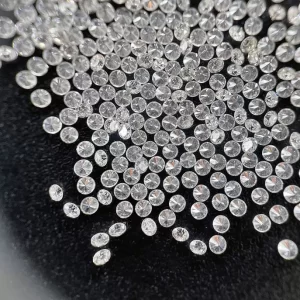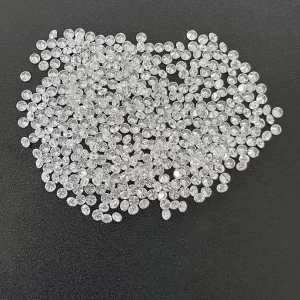G H Color VS1 SI1 HPHT Lab Grown Melee Diamonds 1mm 1.5mm 2mm
1mm – 2mm G-H Color VS1-SI1 HPHT Lab Grown Melee Diamonds
Lab Grown Melee Diamonds Description
Lab-grown diamonds are diamonds grown in the laboratory using equipment that simulate the growth environment of natural diamonds. Both lab grown diamonds and natural diamonds are real diamonds. The main chemical components of lab grown diamonds and natural diamonds are carbon.
Lab grown diamonds is usually produced by chemical vapor deposition (CVD) or high pressure high temperature (HPHT) methods.
For a long time, people believed that diamonds could only be created under high pressure and high temperature conditions, imitating the formation of natural diamonds. This is called HPHT(high pressure and high temperature) method.
The physical properties of CVD synthetic diamonds are within the same range as natural diamonds in terms of hardness, thermal conductivity, and strength. Therefore, CVD synthetic diamonds have the same hardness and durability as natural diamonds, and when cut into gems, they have the same brightness and fire. By controlling the introduced impurities, the optical properties can be changed in a wide range. For example, the crystal can be made close to colorless by controlling the remaining nitrogen level of the gas in the growth chamber. Blue diamonds can be made by adding boron gas; while pink, yellow or other colors can be made using gas mixtures, such as high nitrogen concentration. A special advantage of the CVD diamond production process is that all crystals grown in a growth chamber have the same color and clarity, which is convenient for grading and matching. Through continuous growth and synthesis, the color can be accurately repeated to ensure the reproducibility of color, clarity and size, while also ensuring the supply of high-quality synthetic diamonds for the gem industry.
HPHT 1mm Melee Diamonds
In this article, we’ll explore the process used to create HPHT 1mm Melee Diamonds, as well as their differences from other diamonds. In particular, we’ll discuss their conflict-free status, high-pressure, and small size. We’ll also discuss how to choose a Melee diamond, as well as the benefits of these diamonds. The process of making these diamonds has remained relatively constant over the years, so we’ll be able to compare and contrast the qualities of each variety.
High-pressure, high-temperature method
The high-pressure, heat-processing technique for lab-grown diamonds tries to mimic the conditions that create the natural stone. The pressure used is six gigapascals, and the temperature is around 1600 degrees Celsius. These temperatures promote diamond growth. The high pressure and temperature are achieved by placing the reaction vessel inside a “belt”-type apparatus. When the process is complete, the diamond crystals emerge.
The HPHT method can generate diamonds in relatively short periods of time. This process uses a metal-based flux to dissolve the carbon and precipitate it out as diamond crystals. These diamonds can be magnetic or have microscopic inclusions. The HPHT process yields well-formed diamond crystals. One of its advantages is its cost-effectiveness. The initial cost of the equipment is considerably lower compared to the CVD and HPHT methods. However, HPHT diamonds may need a subsequent treatment to improve color.
HPHT and CVD processes can produce seven to three million carats of rough diamonds each month. On average, each of these polished diamonds is worth between three and four carats. Inclusions are an important aspect of lab grown diamonds, and an experienced scientist can identify them with precision. In addition to their size, a high-pressure, high-temperature process produces an extremely hard-to-reach mineral called niobium.
HPHT creates small, facetted diamonds under a hundred carats. Because of the cost and time involved in producing small gem-quality diamonds, it has been increasingly popular as a production process. Due to its low cost, China is currently supplying lab-grown diamonds in large quantities, and the process produces hundreds of thousands of carats a month.
Type IIa diamonds
Lab-grown diamonds have many benefits, including being conflict-free and ethical, offering multiple choices, and being environmentally friendly. In addition, these gemstones have excellent resistance to pressure. And because they’re lab-grown, they can be mixed in with mined diamonds. For this reason, you can buy melee diamonds with confidence. The following are some tips to identify them:
Before buying, you should know the differences between the types of diamonds. Type I diamonds are made with carbon atoms and are colorless, while Type IIa diamonds contain a small amount of nitrogen. Type Ib diamonds have a yellow or brownish tint. These lab-grown diamonds are also known as Type IIa. Type IIb diamonds have boron atoms, which give them an orange, yellow, or red color.
A good screening device should also be able to detect Type IIa diamonds. This is important for several reasons, including price, purity, and durability. A screening device that can detect Type IIa diamonds costs from $500 to $77,000. GIA developed the DiamondCheck device in 2014, which uses infrared spectra to screen for gems. The device is also available for unmounted colorless diamonds, but this method will not tell if the diamond is natural.
The company behind the CVD method is under fire in the jewelry industry. It’s currently fighting three lawsuits. One is filed by WD against two lab grown diamond producers, Fenix and IIa Technologies of Singapore. Another lawsuit was filed by WD against the parent company of ALTR, R.A. Riam Group, a New York-based manufacturer. The two companies were found to have infringed on patents.
Conflict-free
A conflict-free diamond is a gemstone without any traces of conflict, human rights violations, or environmental pollution. Buying conflict diamonds supports civil war and encourages slavery and child labor. Lab-grown melee diamonds are also a more environmentally friendly alternative than mined diamonds. They have the same optimum appearance and sparkle as natural diamonds without the human costs associated with mining.
The process of producing melee lab diamonds is the same as that of creating other lab-grown gemstones, which is done with HPHT and CVD. The CVD process involves deposition of materials in a vacuum chamber using a gas mixture to create a diamond. Heat and plasma are used to deposit material, which includes carbon, in this case, by heating the gas to high temperatures.
In a single cut, the diamond consists of a table and eight pavilion and crown facets. It may have as few as 17 or 18 facets. HPHT gives the diamond a straw or light-yellow grey color. The lab expert checks for the presence of blue or grey undertones caused by boron, titanium, or a metal flux inclusion. In addition to color zoning, HPHT can affect the clarity of diamonds and the luster of their facets.
The conflict-free nature of these diamonds means they’re ethically produced and responsibly harvested. Lab grown diamonds are far more readily available in the jewelry industry than natural diamonds. GIA has studied them for 30 years and knows how to recognize them. They look like real diamonds, with the same optical and chemical properties. GIA certification. There are many other benefits to buying lab-grown diamonds.
Small size
When purchasing a diamond, it is always wise to look for a conflict-free gemstone. Diamonds from conflict zones are not only rife with environmental and human rights violations, but also contribute to slavery and child labor. Lab-grown melee diamonds are conflict-free and do not have ethically questionable origins. Moreover, they are environmentally friendly as well, which makes them a great choice for jewelry collectors.
For the purpose of making diamond jewelry, HPHT process is used. High-pressure, high-temperature method produces diamonds of excellent quality and in small sizes. Diamonds produced through CVD process are smaller, but not necessarily better quality. Besides, it is important to remember that conflict minerals can influence the quality of diamonds. Hence, if you want to be completely sure of the quality of your purchase, you can report it to human rights organizations.
If you do not have enough time to go for a personal inspection, you can also opt for online buying. Online manufacturers offer an enormous range of melee diamonds, affordable prices, and a 100% satisfaction guarantee. These diamonds are often sold for less than the retail prices of the same size from brick-and-mortar stores. However, be aware of fake diamonds, also called “simulated”, “cubic zirconia,” and “moissanite,” which are harder to identify. When choosing a melee diamond, always check the certificate of origin to ensure authenticity.
Price
The HPHT process creates diamonds from a carbon seed, resulting in a beautiful and sparkly gemstone. While melee diamonds are extremely small, their high quality, unique design, and great shine make them a desirable choice for jewelry collectors. Moreover, they are environmentally friendly and do not require mining, which makes them an ideal choice for the environment. Here’s a look at how they are created.
When buying a Melee diamond, always choose a reputable manufacturer. Some online manufacturers offer these diamonds at affordable prices, but beware of fakes. They may also be labeled as moissanite, cubic zirconia, or simulated diamonds. Choosing the wrong type is dangerous for your health, and purchasing a low-quality stone could be hazardous to your health.
HPHT is the most popular process for growing lab diamonds. It mimics the environment in which diamonds grow naturally in the Earth. The carbon source is placed in a machine with various chemicals. The mixture is then subjected to high temperatures and pressures. This can take hours, even weeks, to create a diamond. This method produces diamonds with a high purity. However, if you are concerned about the quality of the material, you can report abusive and corrupt sources to human rights organizations.
The cost of synthetic diamonds depends on the quality and size of the stone you choose. The cost of HPHT diamonds is considerably lower than diamonds that are grown naturally. A diamond can be as small as one millimeter in size. The average HPHT diamond costs between 30 and 50 percent less than a diamond of the same quality. However, it is important to remember that diamonds are not the same as other gemstones. Depending on the quality, lab grown diamonds can range from a few hundred to more than one mm in size.
G H Color VS1 SI1 HPHT Lab Grown Melee Diamonds 1mm 1.5mm 2mm
















